
Being a long time geek and open source advocate I’ve finally decided to start an open source project for home automation. I’ve always dreamt of being able to wake up to my curtains opening and my heat turning on rather than the usual “beep! beep! beep!” that beckons me to work each day. How about checking on the house when I’m away or open the front door while I’m in the back of the house. The possibilities are endless and my ideas are just beginning to flow.
The project is called Open Automator and it can be found on Source Forge’s site. Its still a very basic framework but its coming along well. It works using the Insteon protocol that communicates over the power lines in your house. Its very similar to the X10 of yesteryear but with updated speed, reliability, and redundancy. It costs a little bit more but it will be well worth it. These devices can be found all over the internet from sites like smarthome.com.
This first rendition will be geared toward the iPhone and Simple Home Net’s EZServe which communicates via an XML socket connection. That being said, I will be making this application very flexible allowing for many different types of implementations, not just Insteon either. The application is Java based with Maven being used for building and dependency management. This will be coupled with Spring and Hibernate to manage database and model view support. The final product will have Jetty and some sort of SQL engine rolled in to make the application extremely portable and platform agnostic.
I will be writing a lot more about this project in the months to come as well as recording some online videos about how it works and how to set it up. I would like to make this product as simple as possible so its usable by the masses. Just because its open source doesnt mean its going to be complicated. If you are interesting in being a developer please let me know.
I have owned my 1973 BMW 2002 for 3 years now and put in countless hours of work and changed out nearly everything, except the drive line. Two weekends ago I went up to my friends shop to finally change it all out. I have been running the stock setup from the clutch back for too long. Also, the lack of a 5th overdrive gear is hurting my gas mileage.
The install went pretty smoothly and took only a day to accomplish. While we were putting in the new transmission and driveshaft we also threw out the stock open differential for a 3.9:1 limited slip. I have said this after numerous projects before, but wow it feels like a new car! The transmission is smooth and the shift throw is much shorter and tighter. In conjunction with the new differential gear ratio the gets off the line quicker. Also, since power is put down the wheels evenly it comes out of corners like a race car. Previously with my open differential the car ‘wiggled’ as it regained traction after a hard corner due to the fact that is sends power down unevenly.
To see pictures of the installation check out the Flickr set.
Open differential versus limited slip differential
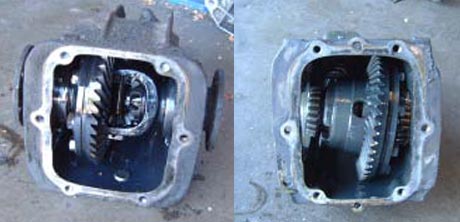
I’m not going to go into great detail regarding all of the differences because that can easily be Googled. I just wanted to show the the main difference. On left we have my stock differential which is an ‘open differential’. On the right we have my new Limited Slip Differential (LSD) with a gear ratio of 3.9:1.
The major difference and also the major weak point of the open differential are the spider gears. This allows the wheels to spin independently. With the car in the air, I can spin one back wheel and the other one will spin in the opposite direction. The limited slip on the other hand doesnt have those gears. Not only can it handle more power it also makes locks the wheels together. Putting the car in the air and spinning one wheel will make the other spin in the same direction. More information can be found at howstuffworks.com.

Well, the victorian ages are finally over. The internal combustion gasoline engine has replaced the need for steam and coal. People have devices in their houses to talk to one another and we no longer burn oil to read at night. These were also the times when we understood electricity well enough where we could really start building the unimaginable. Although nixie tubes were created in the 1950′s, neon signs have been around since the early 1900′s. I have always had an interest in these interesting little tubes and decided to give them a period correct home, albeit strange.
 This project started out from a kit from tubeclock.com. The only other thing I really needed was a proper clock case which eBay gladly provided for around 20 dollars. The only other things I needed were a few hand tools, clamps, and some wood scrap. As you can see from the picture to your left (click to enlarge), I cut two straps of wood and glued them to the inside of the clock. This served as the mounting point for the tubes. After that, it was a matter of lining everything up nice and plum before I drilled two mounting holes. To finish the project, I smoked the glass to give it a patina’d look.
This project started out from a kit from tubeclock.com. The only other thing I really needed was a proper clock case which eBay gladly provided for around 20 dollars. The only other things I needed were a few hand tools, clamps, and some wood scrap. As you can see from the picture to your left (click to enlarge), I cut two straps of wood and glued them to the inside of the clock. This served as the mounting point for the tubes. After that, it was a matter of lining everything up nice and plum before I drilled two mounting holes. To finish the project, I smoked the glass to give it a patina’d look.
All in all it was a pretty simple and fun project to bring some nixie tubes into my home. In total the project was less than 200 dollars with most of it being spend on the tube kit. More pictures can be found in this flickr album.

What is a nixie tube?
As you can see from the picture, its a metal apparatus that sits inside a glass tube (removed in this photo) that is filled with neon gas. When an electrical charge is applied to one of the ten digits, cathodes, they glow. They come in many different shapes and sizes and can be controlled in a number of ways. In this case, they are used to display the time. To read more about how they work and where they have been used check out the nixie tube wikipedia article. Thanks to the evil mad scientists for the photo.
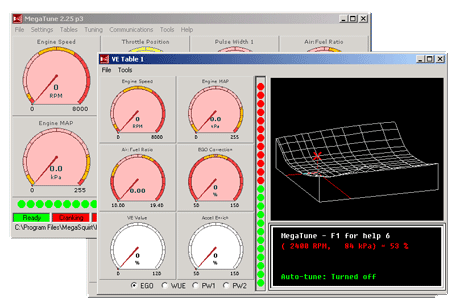 Its been a long time since I last tuned the car ever since I started on the new M3 motor. Just as I was getting back into practice and tuning for efficiency given the high gas prices, a friend gave me his fuel map for a similar car also with Individual Throttle Bodies (ITB’s). After about 30 minutes of tuning the car ran superbly!
Its been a long time since I last tuned the car ever since I started on the new M3 motor. Just as I was getting back into practice and tuning for efficiency given the high gas prices, a friend gave me his fuel map for a similar car also with Individual Throttle Bodies (ITB’s). After about 30 minutes of tuning the car ran superbly!
It had taken me quite a long time to get where I was and from the looks of the map above it would have taken me several more outings. One of my main trouble points was coming back off overrun and right off idle. The latter is a common problem with ITB’s that normal cars dont have with one throttle body. When the throttles quickly open the pressure drops to near full atmosphere and therefore we are getting much better volumetric efficiency requiring more gas.
So far everything is performing wonderfully. The hesitation off idle is gone and the power band is strong all the way up. Also, overrun back onto wide-open throttle is amazing. The fuel efficiency appears to have improved as well. This may not make sense to some but hopefully this is useful to somebody out there (click on the picture above to see a larger image).
 I’ve waited too long to take the plunge and start the tool collection I have always wanted. For years I have had an assortment of tools scattered between my various toolboxes, my car, and the friends who like to ‘borrow’ them. Now they finally have a place to call home.
I’ve waited too long to take the plunge and start the tool collection I have always wanted. For years I have had an assortment of tools scattered between my various toolboxes, my car, and the friends who like to ‘borrow’ them. Now they finally have a place to call home.
Although I have never owned a chest like this before I feel good knowing they are Craftsman and guaranteed for life. Having used them in other shops and hearing only good things from all my friends I know they are going to last. The price wasnt too bad either. I also opted to stuff the drawers even more with a new set of 150 piece metric and assorted SAE sockets and wrenches. Now if only I had a real shop to put these in. For now, my front stoop and back yard will have to do.
I posted this over at SEOmoz’s YOUmoz blog, their user generated blog. If you happen to be a member and like the article please vote for it so it will get promoted on their main blog.
From SEO and the Semantic Web on YOUmoz:
With the proliferation of the Semantic Web, all of our data will be structured and organized so perfectly that search engines will know exactly what we are looking for, all of the time. Even the newest of newbies will be able to create the most well-structured site that would take tens of thousands of dollars today. Everyone’s information will be so precise and semantically correct there will be no need for Search Engine Optimization anymore!
The fact of the matter is, this is never going to happen. Being a long-time SEO practitioner myself, I am very interested in the ramifications of the Semantic Web on today’s search, especially because I am tasked with optimizing Twine when it first becomes publicly readable this summer.
Before we dive too deep, let’s first look at what SEO experts and professionals do today. In a nutshell, we research, study, and test hypotheses learned by watching the heuristics of a search algorithm. We implement by writing clean and semantically correct HTML in certain combinations in order to allow robots to easier asses the meaning of a page. We use CSS to abstract the presentation layer, we follow good linking structures, add proper metadata, and write concise paragraphs. We organize our information in a meaningful way to show bots clean parse-able HTML. In some sense we are information architects, in another we are marketers.
But what would happen if a search engine company published their algorithm? Although that probably isn’t going to happen anytime soon, what if they would tell us exactly what they were looking for? That’s what the Semantic Web is going to do to search. Just the other day Yahoo announced SearchMonkey for just this purpose. It is only going to get bigger. Being told how to mark up your information certainly takes a lot of the guesswork out of it. But in terms of the role of the SEO expert or professional, I don’t think we can retire just yet.
The Semantic Web is organized by people just like the Web of today. The only difference is that now we are going to organize around better standards. Just as people have a hard time organizing their closets, attics, and garages, people have a hard time organizing their websites. Although the Semantic Web will add structure to the Internet, make it easier for novice users to create structured content, and change the way we search, there is still a need for experienced help.
Enter SEO. Some of our roles may have changed, but for the near future there will be still be a lot of similarities. The need to study and analyze robot behaviors to better tune information isn’t going away. They will still have to be on top of the emerging trends, search technologies, and organic ways to drive traffic. The fact of the matter is, nothing is going to change drastically for a while. In the near term, I am mostly worried about how to integrate Twine into the Web of today.
Not very semantic, huh? Well, that’s not say we aren’t going to integrate with microformats, display RDF in our pages, and publish our ontology. All of this is extremely important as the Semantic Web emerges; however, in a world where search is run by Google we have to cater to them. There are a growing number of semantic search engines and document indices out there, which are definitely raising awareness to the mainstream. Yahoo just jumped on the semantic bandwagon publicly and you know Google can’t be too far behind.
In conclusion, there’s nothing to worry about anytime soon. The SEO expert’s salary isn’t going back into the company budget. We still have to tune our pages to the beat of Google’s drum for the time being. When things do take a drastic turn, we will adapt and overcome as we always have. That’s what good SEO does. As for me, I will tune Twine just as I used to tune pages over at CNET, following the teachings of Sir Matthew Cutts et al.
Unfortunately its been a while since I have written anything new and interesting here although I have been working on some very exciting stuff (more on that later). In the meantime, Josh Dilworth from our great PR team at Porter Novelli submitted my last article to semanticweb.com and they published it! Its the first thing I have ever written that has been published somewhere besides this dinky little blog  . Anywho, for those who didnt read it the first time, here is the article on semanticweb.com.
. Anywho, for those who didnt read it the first time, here is the article on semanticweb.com.
A while back I commented on a Tech Crunch article quoting my CEO regarding keyword searches in the Semantic Web space.  My comment was later quoted on the Faviki blog, a Semantic startup involving tagging web pages with semantic wikipedia data. Finding this prompted me to start writing more about the Semantic Web on my own blog.  This is actually the first time I have ever posted about someone else’s post.
(The following is based on a presentation I gave on the subject in September of 2007.)
Tags the way they are implemented today
The way the better Web 2.0 sites implement tags involves faceting. I have discussed this in a previous blog post regarding faceting with Lucene and SOLR, but it in a nutshell, it allows you to group together documents or objects based on attributes. For example, give me all documents about ‘George Bush’ and ‘Washington’. The problem with these attributes is they have little or no value on their own and they certainly they are not understood by computers. They are just strings denoting some type of concept. Here is a short list of limitations which I feel the Semantic Web web will address:
- Tags do not provide enough meaningful metadata to make meaningful comparisons
- More information is needed besides their origin
- Tags are essentially a full text search mechanism, although faceting helps
- Need more relationships between tags and the objects they pertain to
The solution, tags as objects
Allowing users to tag an object with another object we can make extremely interesting comparisons; discerning a lot more information about the original object becomes simple and accurate. With this type of interrelationship we can pivot through the data like never before, not with full text search but object graph linkages that machines and humans can understand. Lets go over an example.
Lets say a user adds a note into our system ranting about a beet farmer who lives in Washington state by the name of William Gates. The user goes on to discuss his beets and farming techniques in great detail, mentioning nothing about software and Windows Vista of course. In the current Internet model the user would tag this note with strings like, ‘William Gates’, ‘Bill Gates’, ‘beets’, etc.
Now another user comes along and starts digging through documents tagged ‘Bill Gates’ to try and find new articles about Vista. Unfortunately, many searches will turn up bad results, especially if the density of the word ‘Bill Gates’ is great enough in the document about beets. That being said, the other direction would work more as intended, searching on the tags ‘Bill Gates’ and ‘Beets’ would yield more expected results.
In the Semantic Web model, the document about William Gates the beet farmer would be tagged with the William Gates object which could contain a plethora of metadata, his location, occupation, etc. Now when we look at this document there is no guessing as to what it is referring, especially from a machines point of view. This is exactly what the Semantic Web was built for. In this model we are not relying on linguistics, natural language processing, or full text search. We are relying on hard links that machines can understand and relate to.
The disambiguation page (was the tag page in Web 2.0)
What about regular string tags? The Semantic Web cant possibly understand everything?! The fact of the matter is, thats true. We still support regular string tagging. Some things are not proper nouns and less concrete, like adjectives and verbs. They may not yet deserve their own object; however, lets think about actual language here for a second. The semantics behind how we describe things.
Take the adjective ‘cool’. Well, first of all, what are you looking for? Nouns? A grouping of multiple nouns? Probably ‘cool’ nouns. A search on this tag could turn up anything and everything from many different levels. It could start by pulling in a definition from Wikipedia. Then it could group together a list of groups tagged cool like the ‘Super Cars’ group or the ‘Fast Cars’ group. It would also show you users tagged ‘cool’ and documents tagged ‘cool’. But where it becomes really interesting is where you find the ‘cool’ string tag on a tag object! Now you can find proper noun tags like ‘Ferrari’ as well as ‘Super Cars’ the proper noun.
Joining these tags together in a search would yield detailed results from rich metadata like a list of Ferrari’s over the years represented as objects. Each car object would contain detailed specs on engine type, weight, horsepower, etc. Then by examining the ‘Ferrari Enzo’ object we can find all the people who used this tag on their bookmarks, links, documents, or other objects they created. With this information you can connect with these people, join their groups, and further your search for whatever it is you are interested in. The point is, everything is related at many different levels. What links them together are adjectives and verbs that describes them.
Conclusions
To be able to come at your data from every angle is important. Everyone thinks differently and everyone searches differently. The truth is, I think its going to be a while for machines to really understand what us humans are talking about. Its up to us to help organize data in a format that is machine readable so the machines can share, but in return it allows us to perform incredible searches likes never before.
There are many common misconceptions around the Semantic Web. It is a very broad term which has many facets. We are going after what I feel is an attainable portion of this idea. Our platform may not try and fully comprehend and reason what the term ‘cool’ means like a human does but you are a human. You the user understands what this term means and just how to use it. If not, our platform will definitely try to help.
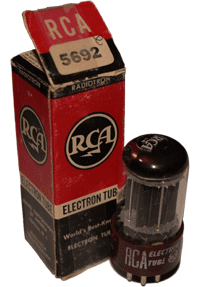 Simply put, a basic vacuum tube is much like a light bulb. In a light bulb, negatively charged electrons travel through the filament colliding into the surrounding atoms but in a vacuum tube the electrons jump off the filament onto a positively charged plate called an anode. This type of vacuum tube is called a diode. What it does is convert AC to DC. This basic idea has been around since 1904 and later perfected in 1907. Since then many variations have come and gone but the same basic concept hasnt changed. The tube you see to the right is an RCA 5692 triode tube from the 1950′s. My newest amp requires three of them on the input side but more of that later.
Simply put, a basic vacuum tube is much like a light bulb. In a light bulb, negatively charged electrons travel through the filament colliding into the surrounding atoms but in a vacuum tube the electrons jump off the filament onto a positively charged plate called an anode. This type of vacuum tube is called a diode. What it does is convert AC to DC. This basic idea has been around since 1904 and later perfected in 1907. Since then many variations have come and gone but the same basic concept hasnt changed. The tube you see to the right is an RCA 5692 triode tube from the 1950′s. My newest amp requires three of them on the input side but more of that later.
Over the past 100 years they have appeared everywhere in world of science and technology. They were in televisions, radios, radar, tanks, phone networks, stereos, and really almost everywhere. They eventually became the backbone for the first computers. Today, most tubes have been replaced with much the much smaller and modern semiconductors we see today. Nowadays they are often found among radio enthusiasts, high-end or vintage stereos, and in guitar amps.
So whats so great about vacuum tubes in an amplifier?
It really depends on who you ask. This has been a long drawn and heavily debated issue ever since the first solid-state stereos were introduced in the 70′s. For me, I like all things vintage. Especially vintage technology. I love their simplicity, their nostalgic character, and the attention to detail you get from a hand built piece of equipment. For just the engineering reasons alone I love them. All that being said, they sound wonderful! They are warm and rich and deep. The sound can be so real and the stage so perfect that Neil Young’s harmonica sounds like its next to you and Stevie Nix is singing in your living room.
For me, its a really the entire experience; the charm and character that they bring along with a good piece of vinyl is amazing. The solid-state guys say that the sound isnt right due to the electron cloud inside the tube which is responsible for amplifying the sound. The analog guys claim its reality, its lifelike, and a lot of music was recorded this way since the beginning. Either way, I seem to enjoy them.
What is an RCA 5692 tube and more importantly, what is a triode?!
Lets not worry to much about the RCA tube you see above and look more at what a triode itself is. There were so many different ones built from so many countries over so many years it can be dizzying. All that really matters is that they are like cars. Some were well built and some were not.
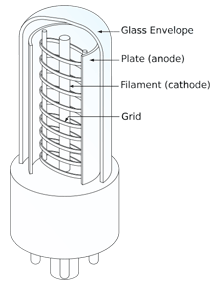 To the left is a basic diagram of a triode vacuum tube (thank you Wikipedia). The main difference here between a diode and a triode is the grid surrounding the filament.
To the left is a basic diagram of a triode vacuum tube (thank you Wikipedia). The main difference here between a diode and a triode is the grid surrounding the filament.
Remember that the filament is emitting negatively charged electrons that are picked up by the anode, but in a triode tube, there is a grid or screen in between. By applying a negative charge to this grid you can control the amount of electrons that will contact the anode.
There is a lot goes into the circuit topology the dictates how to charge the grid but thats another story for another day. The two amplifiers I currently have are both powered by triodes, both on the input and output side, but their design differs in the way the tubes are implemented.
A few months back I started sketching out plans for a do-it-yourself record player. Since then, not much has gone on due to my friend the electronics expert being out of town so I decided to source some parts. I turned to a Chinese company called diyhifisupply.com. China you say? Well, over the past few years China has really become a key player in the DIY world of high fidelity. They are creating high quality components a great prices from the platter you see below to oil filled caps, tubes, and other various parts.
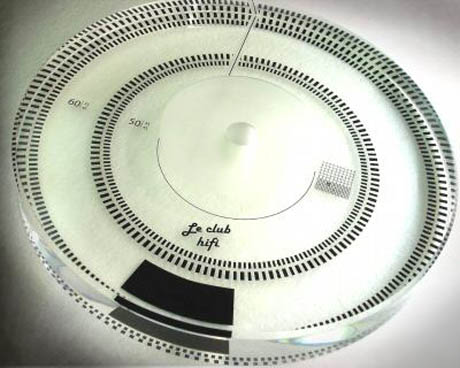
This platter was laser cut out of 40mm thick acrylic at a final diameter of 298mm. Its truly is a beautiful piece of work. The markings on the platter are for timing it with a strobe. Below is a photo of the bearing that I ordered along with it. It too is a very nicely machined piece of work with a self-oiling design using rifles to push the oil back up to the bearing. When everything is all connected together it turns very smoothly.
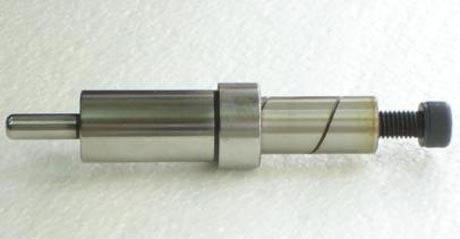






 I’ve waited too long to take the plunge and start the tool collection I have always wanted. For years I have had an assortment of tools scattered between my various toolboxes, my car, and the friends who like to ‘borrow’ them. Now they finally have a place to call home.
I’ve waited too long to take the plunge and start the tool collection I have always wanted. For years I have had an assortment of tools scattered between my various toolboxes, my car, and the friends who like to ‘borrow’ them. Now they finally have a place to call home.  Simply put, a basic vacuum tube is much like a light bulb. In a light bulb, negatively charged electrons travel through the filament colliding into the surrounding atoms but in a vacuum tube the electrons jump off the filament onto a positively charged plate called an anode. This type of vacuum tube is called a diode. What it does is convert AC to DC. This basic idea has been around since 1904 and later perfected in 1907. Since then many variations have come and gone but the same basic concept hasnt changed. The tube you see to the right is an RCA 5692 triode tube from the 1950′s. My newest amp requires three of them on the input side but more of that later.
Simply put, a basic vacuum tube is much like a light bulb. In a light bulb, negatively charged electrons travel through the filament colliding into the surrounding atoms but in a vacuum tube the electrons jump off the filament onto a positively charged plate called an anode. This type of vacuum tube is called a diode. What it does is convert AC to DC. This basic idea has been around since 1904 and later perfected in 1907. Since then many variations have come and gone but the same basic concept hasnt changed. The tube you see to the right is an RCA 5692 triode tube from the 1950′s. My newest amp requires three of them on the input side but more of that later. To the left is a basic diagram of a triode vacuum tube (thank you Wikipedia). The main difference here between a diode and a triode is the grid surrounding the filament.
To the left is a basic diagram of a triode vacuum tube (thank you Wikipedia). The main difference here between a diode and a triode is the grid surrounding the filament.